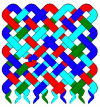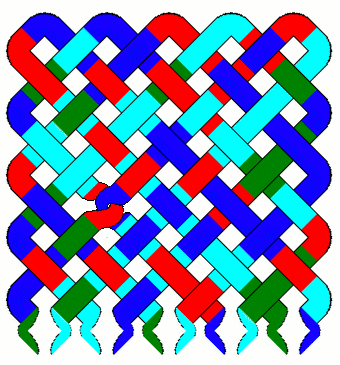GCPP:Proposal-Flounder
Puzzle Codename: Flounder
| Contact | |
| Username: | cedricshock |
| Additional contact info: | Playable Demo
Sweetums on Midnight |
| Project forum thread: | Flounder |
Game concept
Tug on and twist interwoven strings to creates bolts of cloth.
I previously described this idea on the forum. There is a playable demo of some of this idea (rotated by 45 degrees).
You have a loom of some size (say 5 by 5 because it looks nice) threaded with threads that run from an open end of the loom up weaving over and under each other until they reach a side of the loom, where they turn 90 degrees and weave again (making two more turns) until eventually they come out the open end of the loom again. Each of the threads is many-colored. Half of each thread is "on top" and is the color for the squares of the loom.
Objective
The goal is to make patches of cloth of all the same adjacent color. Each patch must be at least 2 by 2 in size. Only the parts of threads above the work, or "on top", count towards building these patches. When the patches of cloth are made the portion of thread used in their construction is removed and more thread is pulled in from outside the loom to fill in the empty spaces.
Gameplay
You can play the game with tugs and twists!
Tugs
The main mechanism of manipulating the loom is to tug on one of the dangling threads so that all of the colors are pulled through the loom, advancing one position along the path of the thread.
Twists
A second mechanism of manipulating the loom will appeal to more advanced players. A player can click on one of the woven squares of the loom to turn it into a twist, or on a twist to turn it back into a regular square. Twisting or untwisting strings counts as two moves (because it changes two strings). A twist changes the arrangement of the board by looping the two strings around each other so that they don't cross, but leave the square after making a 90 degree turn. A twist cannot be used in a pattern (It has both colors visible on top - not good for weaving) but it allows skilled players to manipulate their luck in string colors and adds depth to the game. Twists should only go in the board one direction (parallel to the loose ends) to prevent a player from making loops that could not be filled from the loose ends.
Scoring
The game is scored on the size of patterns and cascading chains of patterns constructed and efficiency in use of moves. Large solid patches of cloth (2 by 4, 3 by 3, etc.) should be worth quite a bit. Gold thread (described below) would almost be required to set up anything solid and large.
A possible scoring method: The score for a move is the square of the number of individual squares cleared in the move. For example one 2x2 patch would be worth 16 points, A 2x3 patchwould be worth 36 points, two 2x2 patches in a combo would be worth 64 points, etc. The score is multiplied by 2 for using a black strand, and by 4 for a gold strand. Chains, due to coming at the cost of 0 moves, are scored on diminishing returns. Each step in a chain reaction after the first is worth half as many points as the previous step.
When a gold thread is pulled out of the loom the player is docked 100 points for wasting gold or stealing from their employer. A lost black thread incurs a 60 point penalty.
Variability
The initial loom and the colors added when a string is tugged or a piece of cloth cleared are random. The initial loom has no patterns in it.
End criteria
The puzzle ends when 200 moves have been completed. An unwinding spool of thread shows how far through the game the player has progressed.
It could also end after a set number of patterns or points, or some combination of all three. I prefer ending it after a set number of moves as it is simplest and guarantees a similar length game for all levels of play.
Difficulty scaling
Adding colors of thread increases the difficulty in a manner similar to bilging (more colors can actually be "easier" for more skilled players). Increasing the minimum size of a pattern greatly increases difficulty.
With few colors in the threads it is trivially easy for a player to get small patches. Adding more colors to the threads makes the difficulty rise. The movement in of new threads in a foreseable fashion allows skilled players to construct cascading patterns.
The game can be further expanded to make it more challenging and interesting for advanced players. Here are a couple of recommended improvements:
Black Strands
At medium levels black thread can be randomly added to strings (1/50 chance or about 5 per game). A black thread matches any color (or colors!), but only matches as part of the pattern when it is used as part of TWO 2x2 squares. Black makes constructing 2x2 squares harder, but constructing two of them together easier.
It can be thought of as adding weight or detail to the cloth.
Lost black thread incurs a penalty for wasting the brigands' time milking the Kraken.
Gold Strands
These add sparkle to cloth, and should be used sparingly in places of prominence!
At higher levels gold thread could be randomly added to strings (1/75 chance or about 3 per game). It matches any color when it is part of FOUR 2x2 squares. These must be all the same color, because it's not possible otherwise. Gold will get in the way, but it also makes it easier to construct 3x3 squares of the same color.
A gold thread tugged out of the side of the loom would incur a "Lost Gold" or "Stealing from your Employer?!" type penalty.
Crafting type
Weaving
Known problems
Which threads are "on top" and connected together in the pattern can be hard to discern visually. A solution to this is described below; it is essentially a different game.
Notes
1. The graphics should display the threads so that the portion above the loom is much larger than any piece hidden underneath by having the threads be broad and the spacing between them narrow, sort of like this:
Additionally the thread currently on the back side of the work could be displayed with a tint of the color to make it appear as though it is not currently active, but can become so.
The threads also need to be big so that they can accomodate distinctive patterns for the different types (colors) of thread. It'll be a bit of a trick fitting enough of the pattern into the behind threads to make sure the game is accessible to everyone. Concerning patterns and textures horizontal or vertically distinctive textures are a no-go since the thread is rotated as it goes around the loom. Good textures would be things like "x"s, waves, speckles, splotches, etc. Textures such as lines perpindicular to thread and lines parallel to thread would be less desirable.
2. Twists have a "handedness" that could be counter-intuitive. I suggest that the "top" side connections of a twist maintain connected and that the bottom ends are swapped (consistent with having more changes happen at the bottom than at the top of the board).
3. It's possible to have twists in both directions, but it makes spooling on the thread impossible, probably requiring new colors to spawn in the threads like in shipwrighting. This doesn't allow as much planning about what you'll get, but does add another twist to the game. I kind of like the restriction of only being able to twist one way. Tugs move the thread colors vertically through the weave and twists move the colors between threads (horizontally). This might be too strightforward for skilled crafters.
4. Other shapes of looms are possible, even circles and anvils, and the tugy parts don't all need to be on the same side, or even on the outside. A simpler layout is probably better and definitely more usable.
Additionally, In the original discussion Nemo had the following helpful suggestions:
What other risk/reward decisions can you give the player?
Risk of time/moves to the reward of successive clears: After one clear of a given color, no more threads of that color are added until a different color is cleared. Successive clears of that same color with no clears of other colors grant exponentially greater scores.
Risk of knots to the reward of greater freedom: Instead of a move/time penalty, have every twist come with a chance of a knot. If two threads are knotted, they can't move until the knot is cleared (either color counts). This could possibly alleviate distillery-syndrome's troubles.
5. The old demo without the 2x2 restriction is still available for comparison.
Images
No-Back Variation
The back sides of threads could be entirely removed so that the foreground thread color stretches all the way from the last thread it was under, over a thread, and on to the next one it goes under. This is visually very appealling, and (speculation) might actually make the puzzle harder to manipulate (less like distilling)
This has a couple disadvantages. First, removing the back makes it harder to set up large patterns (no where to hide the key pieces). Secondly it requires a different type of twist which forces the possibility of cyclic threads, adding complexity which could possibly be used to make chains more likely.
This idea is further tossed about a bit on the forum, with an illustration.



